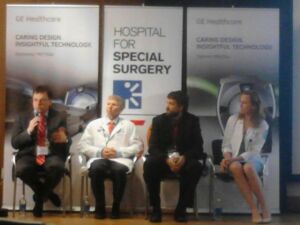by
Nancy Ryerson, Staff Writer | May 16, 2013

Richard Hausmann, Mathias Bostrom,
Kevin Koch and Hollis Potter
Any patient with metal implants can now receive a clear, readable MRI scan thanks to new technology from GE Healthcare. The company unveiled its new software, MAVRIC SL, at the Hospital for Special Surgery on Wednesday in New York City.
The technology was developed specifically to address the need to accurately image soft tissue and bone in patients with metal implants in the hip, knee and other joints, but can be used on anyone who has metal in their body, such as dental implants.
Before this technology, doctors used X-rays to image metal implants but were often unable to see the soft tissue around the implant, sometimes leading to biopsy or exploratory surgery. Because MRI technology contains strong magnets, metal objects are not permitted in the MRI room for safety reasons.



Ad Statistics
Times Displayed: 2147
Times Visited: 10 Fast-moving cardiac structures have a big impact on imaging. Fujifilm’s SCENARIA View premium performance CT brings solutions to address motion in Coronary CTA while delivering unique dose saving and workflow increasing benefits.
"This was driven by clinical need," said Dr. Hollis Potter, chief of MRI imaging at Hospital for Special Surgery and a lead member of the development team. "My orthopedic colleagues have said, I have patients who have orthopedic implants, and they hurt. I've done an X-ray, I've examined them, I've done everything I think I can to help them and I can't figure out how to help this patient."
More than 1 million hip or knee replacement surgeries are performed in the U.S. each year, with the need for second surgeries on the rise as increasingly younger patients receive and then outlive their initial implants.
Patients with pain or a change in their movement are often difficult to help, as traditional radiographs couldn't catch details like abnormal swelling around the implant, or evidence of arthritis around the implant.
Potter decided to approach GE as well as two other manufacturers with her problem. For the next four years or so, GE physicists communicated with her and the Hospital for Special Surgery to develop technology that could create non-distorted images that included metal implants.
The technology the team eventually developed works by taking individual "shots" of an image, each one capturing signals from a different frequency component that will make up the final image. As an object near a metal implant experiences frequencies that lead to distortion and signal loss, the range of frequencies MAVRIC SL captures preserves signal and minimizes distortion when the image is reconstructed.
Besides using it to treat patients with pain or discomfort, the technology can also be used to screen patients that are at risk for complications from their implants. Data published by the Hospital for Special Surgery found that MRI imaging using MAVRIC SL can help identify abnormal synovial thickness, a predictor for an implant that will be problematic. Non-MRI indicators, such as age, sex and BMI, were found to be unhelpful markers.
"Now we can put patients into categories —- we can watch and wait, or send them to revision surgery, so we can give them an answer with about 40 minutes of scanning," said Potter.
Potter said she plans to use the technology regularly in her practice.
On the GE side, the development team enjoyed the opportunity to create an application that patient experience directly inspired.
"This is something where an application gives an answer to a question a patient asked," said Richard Hausmann, president and CEO of GE Healthcare MRI.
MAVRIC SL will be available in two months as a software upgrade for use with GE 1.5T and 3.0T MRI systems.

